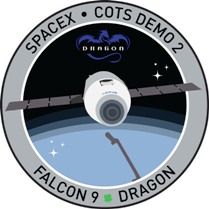First Attempt by a Commercial Company to Send a Spacecraft to the Space Station-
A New Era in Spaceflight- We stand at the dawn of an exciting new era in space travel: one in which NASA and commercial companies work in partnership to provide rapid advances in space transportation.
This SpaceX mission is a milestone in that transition, marking the first time in history that a commercial company will attempt to send a spacecraft to the International Space Station, something only a few governments have ever accomplished. This is a demonstration mission, a test flight primarily designed to provide NASA and SpaceX with valuable insight to ensure successful future missions. The SpaceX Falcon 9 rocket with its Dragon spacecraft was stood vertical overnight on the launch pad at Space Launch Complex-40 at Cape Canaveral Air Force Station in Florida. Liftoff is scheduled for 4:55 a.m. EDT Saturday.

Mission Highlights- During the mission, Dragon must perform a series of complex tasks, each presenting significant technical challenges (timeline could change):
● Day 1/Launch Day: SpaceX's Falcon 9 rocket launches a Dragon spacecraft into orbit from the Cape Canaveral Air Force Station.
● Day 2: Dragon orbits Earth as it travels toward the International Space Station.
● Day 3: Dragon's sensors and flight systems are subject to a series of complicated tests to determine if the vehicle is ready to berth with the space station; these tests include maneuvers and systems checks that see the vehicle come within 1.5 miles of the station.
● Day 4: NASA decides if Dragon is allowed to attempt to berth with the station. If so, Dragon approaches; it is captured by station's robotic arm and attached to the station. This requires extreme precision even as both Dragon and station orbit the Earth every 90 minutes.
● Day 5 - TBD: Astronauts open Dragon's hatch, unload supplies and fill Dragon with return cargo.
● TBD: After approximately two weeks, Dragon is detached from the station and returns to Earth, landing in the Pacific, hundreds of miles west of Southern California.
Pushing the Envelope, Success is Not Guaranteed- Demonstration launches are conducted to determine potential issues so that they might be addressed and - by their very nature -carry a significant risk. All spaceflight is incredibly complicated, and this flight introduces a series of new challenges -- it is only the third flight of the Falcon 9 rocket, the second of the Dragon capsule, and the first for a number of all-new components necessary to berth with the International Space Station. If any aspect of the mission is not successful, SpaceX will learn from the experience and try again.
2nd Flight of the NASA COTS Program- This is SpaceX's second demonstration flight under a 2006 Commercial Orbital Transportation Services (COTS) agreement with NASA to develop the capability to carry cargo to and from the International Space Station. To date, SpaceX has received $381 million for completing 37 out of 40 milestones worth a possible $396 million set in that agreement. Completed milestones include the first test flight in December 2010, during which SpaceX became the first commercial company to send a spacecraft to low-Earth orbit and recover it successfully, something that only three governments - the United States, Russia and China - have ever done.
Next Up- Once SpaceX has successfully demonstrated Dragon's ability to berth with the space station, it will begin to fulfill a 2008 contract signed with NASA for a minimum of 12 flights carrying supplies to and from the space station. Without the space shuttle, Dragon is the only spacecraft in the world capable of returning significant cargo from the space station. Falcon 9 and Dragon were designed to carry astronauts in the future; these cargo missions will yield valuable flight experience toward this goal. FMI: http://www.spacex.com/